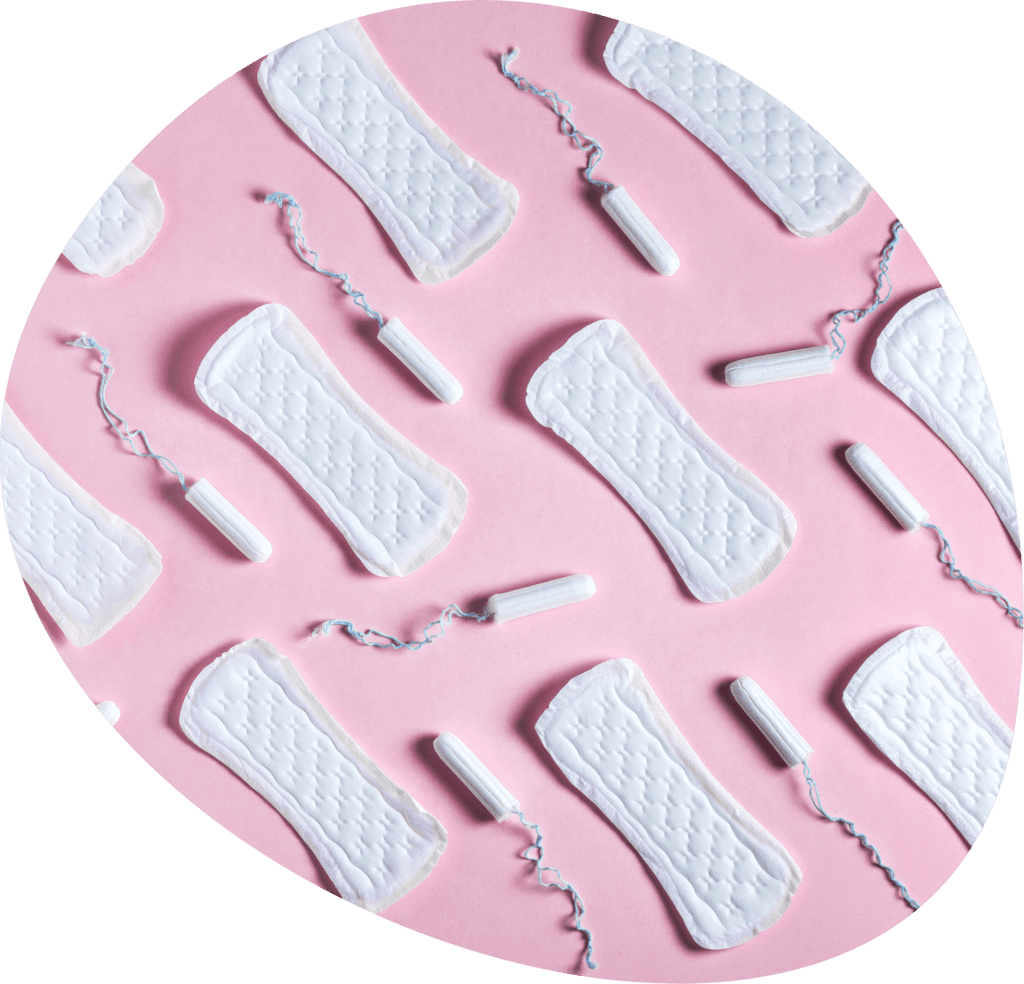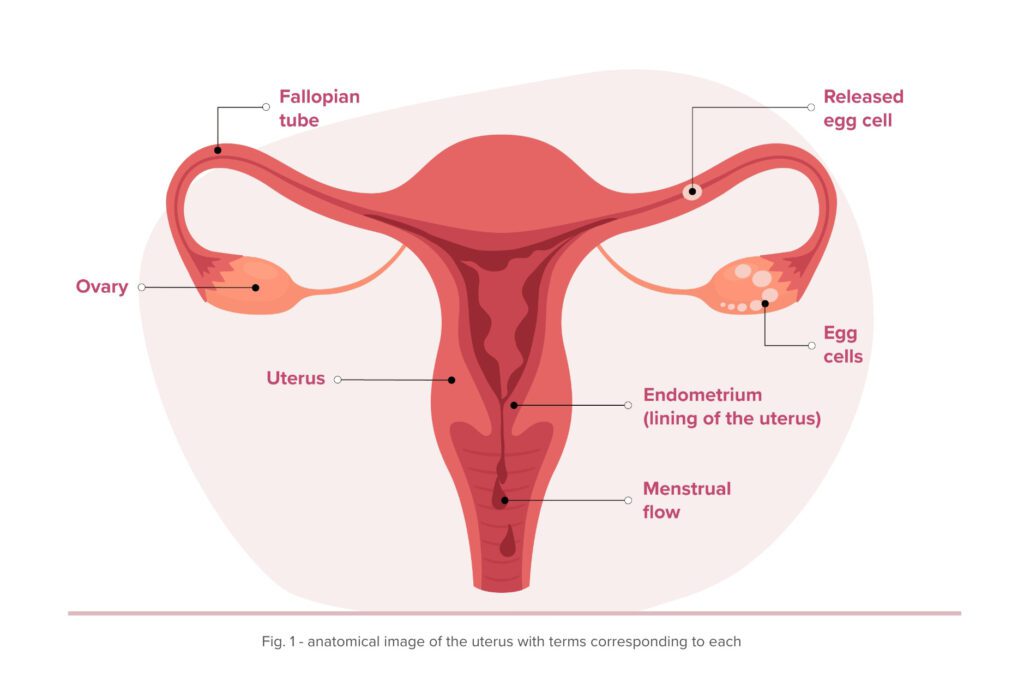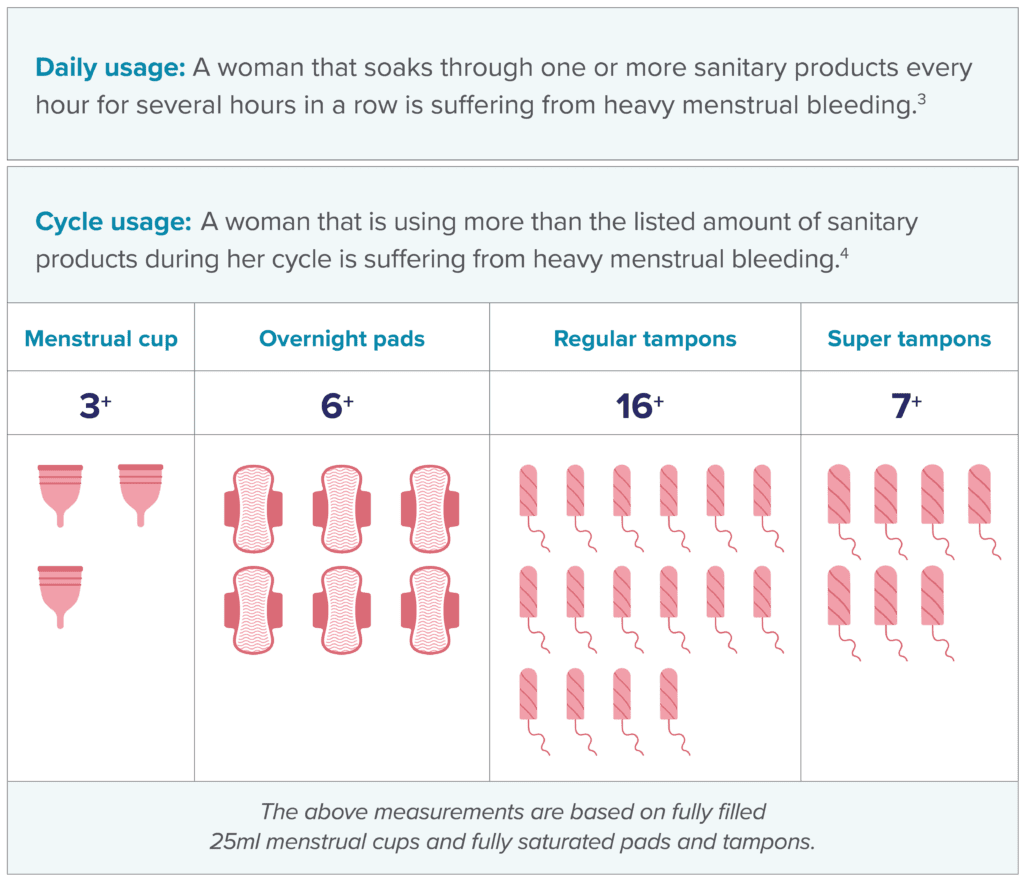Abnormal Uterine Bleeding:
What is it?

Well-woman basics: period health 101
Before we dive into what’s abnormal, let’s start with what’s normal:
A menstrual cycle is a process where the endometrial lining of the uterus gets thicker, prepping for pregnancy. An average cycle is about 28 days and varies for each woman. If a woman does not become pregnant during her cycle, she will shed her lining. This is known as a period.
A period can be an indicator of overall uterine health, and may give women information that could tell them when to see a doctor.
What can a woman expect with a normal period?
- Lasts 3-7 days
- Bleeding 80 ml or less which should require the use of less than 16 regular tampons, 12 regular pads, or 3 full 25 ml menstrual cups during a full cycle
Women should see a doctor about their period if:
- They experience changes in their cycle
- They are bleeding longer than 7 days
- They are passing large clots the size of a quarter
- They are bleeding in between periods or after intercourse
- They are experience extreme pain

AUB facts and stats

will experience abnormal uterine bleeding in their life.

with heavy bleeding find their period disruptive to their mental, emotional and physical well-being

with heavy bleeding find their period disruptive to their sex life
What is AUB?5
Heavy periods – what doctors call abnormal uterine bleeding, or AUB – are pretty common. In fact, 1 in 3 women seeks treatment for AUB.6 AUB is a symptom that results from an underlying medical condition; women suffering from AUB may experience:
- Heavy periods
- Long periods
- Inconsistent or irregular periods
- Painful cramps during a period
So, your normal may not be normal at all. Take our quiz to better understand what your health symptoms might be trying to tell you.
What are the causes of AUB?7
AUB symptoms can be caused by both structural and nonstructural disease states.
Non-structural causes of AUB may include coagulopathy, ovulatory disorders, endometrail disorders, and/or thyroid disorders.
Structural causes of AUB may include polyps, fibroids, adenomyosis, and or malignancies.

Treating AUB
These are common treatment options and expected recovery times for AUB. Selecting the right treatment is dependent on both a woman’s disease state and their unique needs. For patients suffering from AUB caused by fibroids, refer to the fibroid 101 page.

The recovery times listed are not from a single source comparing recovery times. The data listed comes from a variety of sources including clinical studies and recovery guidance provided by major medical institutions.
For hysteroscopic tissue removal: the recovery time is based on estimates provided by the Mount Sinai health system in NY and the guidance they offer to patients based on their clinical experience.
For endometrial ablation: the recovery time is based on estimates provided by the Cleveland Clinic health system and the guidance they offer to patients based on their clinical experience.
For hysterectomy: the recovery time is based on a single randomized control trial comparing short-term outcomes of different approaches to hysterectomy.
Join our community
You are not alone
48% of US women are confident they could identify the five major parts of the uterus, and even less women could identify the difference between fibroids, polyps, and cysts.1
And yet, 75-80% of people with a uterus will be diagnosed with fibroids at some point in their lives.2
Whether you know a little or a lot about your uterus, it’s not always easy to know what’s normal.
Get connected, get educated,
and join the conversation!

Discover the possibilities.

Hey Doc!
This page is for you, too. As you counsel your patients on treatment options, share this page, plus the social posts and email template we’ve created to help your patients understand fibroids better!
Important Safety Information
The Acessa ProVu system is intended to identify and shrink symptomatic uterine fibroids. The Acessa ProVu system is used by trained physicians during laparoscopic surgery under general anesthesia. Rare but serious risks of this procedure include, but are not limited to, infection, internal injury, blood loss and complications related to laparoscopic surgery and/or general anesthesia. This procedure is not recommended for women who are planning future pregnancy. This information is not medical advice. Please discuss the risks and benefits with your doctor to find out if the Acessa procedure may be right for you.
MyoSure tissue removal system is intended to remove unwanted tissue from the uterus. During a MyoSure procedure, a trained gynecologist inserts the MyoSure device through your vagina and then removes the unwanted tissue from inside the uterus. Use of the MyoSure system is not appropriate for patients who are or may be pregnant, or have signs or symptoms of a pelvic infection, cervical cancer, or previously diagnosed uterine cancer. As with any surgical procedure, there are potential risks including but not limited to internal injury, excessive bleeding, and complications related to anesthesia. Temporary side effects may include cramping, bleeding, fever, and nausea. This information is not medical advice. Please discuss the risks and benefits with your doctor to find out if the MyoSure procedure may be right for you.
References:
1. Professional, Cleveland Clinic medical. “Menstrual Cycle (Normal Menstruation): Overview & Phases.” Cleveland Clinic, my.clevelandclinic.org/health/articles/10132-menstrual-cycle. Accessed 20 Sept. 2023.
2. Abnormal Uterine Bleeding – Statpearls – NCBI Bookshelf, www.ncbi.nlm.nih.gov/books/NBK532913/. Accessed 20 Sept. 2023.
3. Hologic, Inc. Data on File; AUB Patient Journey Research, conducted January 2017. Survey of 1,003 women who self-identified as currently or recently experiencing heavy bleeding with need to change feminine hygiene product every hour or more
4. Hologic, Inc. Data on File; AUB Patient Journey Research, conducted January 2017. Survey of 1,003 women who self-identified as currently or recently experiencing heavy bleeding with need to change feminine hygiene product every hour or more.
5. “Abnormal Uterine Bleeding.” ACOG, www.acog.org/womens-health/faqs/abnormal-uterine-bleeding. Accessed 20 Sept. 2023.
6. American College of Obstetricians and Gynecologists. “Heavy menstrual bleeding”. https://www.acog.org/womens-health/faqs/heavy-menstrual-bleeding. Accessed May 3, 2022.
7. Figo Classification System (Palm coein) for … – Wiley Online Library, https://obgyn.onlinelibrary.wiley.com/doi/10.1016/j.ijgo.2010.11.011
8. “Hysteroscopy.” Mount Sinai Health System, www.mountsinai.org/health-library/surgery/hysteroscopy. Accessed 21 Sept. 2023.
9. Chudnoff SG, Berman J, Levine DJ, Harris M, Guido RS, Banks E. SG Chudnoff, et al. Outpatient Procedure for the Treatment and Relief of Symptomatic Uterine Myomas. Obstetrics and Gynecology, 2013;121(5):1075–82. 8
10. Pron G;Mocarski E;Bennett J;Vilos G;Common A;Zaidi M;Sniderman K;Asch M;Kozak R;Simons M;Tran C;Kachura J; ; “Tolerance, Hospital Stay, and Recovery after Uterine Artery Embolization for Fibroids: The Ontario Uterine Fibroid Embolization Trial.” Journal of Vascular and Interventional Radiology : JVIR, U.S. National Library of Medicine, pubmed.ncbi.nlm.nih.gov/14551270/. Accessed 31 Aug. 2023.
11. Consultant, C.O., Lingman, G. and Ottosen, L. (2000), Three methods for hysterectomy: a randomised, prospective study of short-term outcome. BJOG: An International Journal of Obstetrics & Gynaecology, 107: 1380-1385. https://doi.org/10.1111/j.1471-0528.2000.tb11652.x
12. Professional, Cleveland Clinic medical. “Myomectomy: Purpose, Procedure, Risks, Results & Recovery.” Cleveland Clinic, my.clevelandclinic.org/health/treatments/15448-myomectomy#:~:text=You%20can%20expect%20some%20pain,take%20up%20to%20six%20weeks. Accessed 8 Sept. 2023.
13. This survey was conducted online within the United States by The Harris Poll on behalf of Hologic between May 10-12, 2022 among 997 female adults ages 18+, among whom 815 are females ages 30+.
14. Mayo Clinic. Uterine fibroids. www.mayoclinic.org/diseases-conditions/uterine-fibroids/symptoms-causes/syc-20354288. Accessed June 5, 2023.
